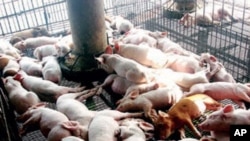Pigs given low doses of antibiotics had more E. coli in their guts, and that bacteria showed an increased resistance to antibiotics, according to new research.
The study confirms the routine practice of feeding antibiotics to food animals increases drug resistance in the bacteria living in those animals.
The practice is common at large livestock operations worldwide. But experts say it is helping spawn new types of antibiotic-resistant disease organisms, fueling a global public health crisis.
California executive Tom Dukes had a close call with one such superbug. He got painful stomach cramps a couple years ago. His doctor said it was a serious intestinal condition called diverticulitis and prescribed antibiotics.
“Started those on Monday morning and by Tuesday night, I really felt like a million bucks,” he says.
But a few months later, Dukes got the symptoms again. Again, he got antibiotics.
Drug failure
This time, though, they did not work. He wound up in the emergency room, in incredible pain.
“I’d never encountered anything like this before," Dukes says. "Out of all the sports injuries and broken arms and things like that, that all paled in comparison.”
Drug-resistant E. coli bacteria were escaping into his abdomen through a tear in his colon. Emergency surgery removed a 20-centimeter section.
Doctors had only one type of drug left that would kill the germs. That saved his life.
Dukes is a self-described workout fanatic who spends a couple hours a day in the gym. So how does an otherwise-healthy person get a life-threatening superbug?
“Although we’ll never know for sure exactly, it seems that the probable cause was basically from eating tainted meat,” he says.
Healthy animals vs. sick people
Animals raised for meat at large livestock operations around the world are commonly given antibiotics to prevent disease and to help them grow bigger with less feed. In the United States, more antibiotics are used for healthy animals than for sick people.
It’s a controversial practice. In a new study, U.S. Department of Agriculture researcher Thad Stanton and colleagues looked at bacteria coming out of pigs fed some of those antibiotics.
They saw “increases in about 20 different antibiotic resistance genes,” he says, including genes for resistance to one type of antibiotic that was not even fed to the pigs.
“We also saw increases in E. coli populations, which were unexpected,” he says.
Stanton notes that most E. coli are harmless, but some do cause disease. And even the harmless ones can pass resistance genes to their not-so-harmless cousins.
Long-running debate
This study, in the Proceedings of the National Academy of Sciences, is just the latest round in a debate that stretches back four decades. It has been known for at least that long that feeding livestock antibiotics generates resistance.
But Liz Wagstrom, chief veterinarian for the National Pork Producers Council says, “The bottom line is, what does that mean for either animal health or public health?”
Wagstrom doubts there is much impact at all. She says controls are in place at every step of the journey, from farm to slaughterhouse to market, to keep bacteria out of the food supply.
“The potential adverse effects of that bacteria being resistant are just very, very small. Close to zero.”
'Extremely concerning'
Not so, says Jim Johnson, an infectious disease doctor at the University of Minnesota and an expert with the Infectious Diseases Society of America.
Over his 25-year career in medicine, he has watched one drug after another fall to antibiotic resistance.
“The resistance that’s showing up in the E. coli that are coming in on meat products from antibiotic-fed farm animals is extremely concerning,” he says
U.S. regulators recently restricted the use in livestock of one vital group of antibiotics and are recommending other limits. Critics say much tighter controls are needed.
Control issues
But the threats are even greater in the developing world, where regulations and enforcement are weaker, says Bernard Vallat, head of the World Organization for Animal Health, OIE.
“More than 100 countries have no appropriate legislation to implement control on those products," he says. In those countries, "there is no control on importation, no control on registration, no control on distribution and use.”
And Vallat says resistant bacteria can travel anywhere in a globalized world.
Experts note that livestock are far from the only source of resistant bacteria. Use and misuse of antibiotics in people is at least as big a problem - perhaps more so.
For people like Tom Dukes, who carries the bacteria in his gut, where the bacteria came from is less important than where they go.
“I kinda live every day knowing it’s still there," he says. "And if it ever gets out again, that they may not have anything to combat it this time.”
It’s a fear that’s growing for patients and doctors around the world.
Antibiotics Breed Drug Resistance in Pigs

Critics call for tighter controls









